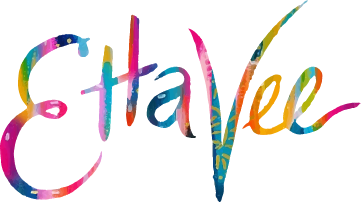Tips for Expressive, Abstract Watercolor Painting
Let’s talk about abstract watercolor painting! I love watercolor for its fun, flowing properties. I do the majority of my large-scale fine artwork in acrylic, but I’ve been exploring watercolor more and more. I take it with me on vacations since it’s so portable, and I love to do watercolor sketches as I’m inspired by my surroundings.
Today I want to talk about two different styles of watercolor painting. One is true abstract watercolor painting, and one is a more expressive representational style with abstract accents.
Abstract Watercolor Painting
Let’s start with true abstracts. I have one major tip for this type of painting – Play!
Play with different brushstrokes
Start by exploring the different kinds of marks you can make with your brush. Follow your intuition and let the brush guide you. This piece is aptly called “Artist’s Play” because that’s exactly what I was doing when I created it! Try your hand at painting swishes, dots, lines, blobs, and any other mark that comes to mind. You never know how well a few brushstrokes might turn out!
Play with the amount of water on your brush
The beauty of watercolor painting is that we can create different results based on how much water is on our brush. Explore what happens when you add a lot of water and drop in some pigment. Explore what it’s like to use a fairly dry brush with watercolor. In this example, I used a lot of water in some portions of the painting and it created a lovely wash effect with crinkly edges. Then I was able to go in once it dried and paint some defining brushstrokes on top to help the flow of the painting.
Expressive Representational Watercolor Painting
Now, let’s talk about what it takes to paint more representational pieces while maintaining an abstract and expressive style.
Plan your composition in advance
When I’m painting a representational piece, I always plan out my composition in advance. Many acrylic artists worry about doing this with watercolor because watercolor is a transparent medium, meaning that in some cases pencil marks and sketches will show through.
If you want to avoid your sketch showing up, try either drawing extremely lightly with your pencil, or choose a drawing tool that will blend well with what you’re painting. In this example, I knew I was going to paint with bright colors and lots of layers. I used a neon yellow gel pen for my sketch because I knew that it would be mostly covered by my painting. And the parts that did show through would just enhance the overall vibrancy of the piece!
Plus, I tend to digitize my pieces and enhance them afterwards in Procreate. For parts of this original sketch like the wine glass, I added outlines digitally in Procreate after I scanned it in and digitized this piece!
Leave space for lighter parts
Once you’ve planned your composition, you should have a better idea of what you need to paint in the different parts of your page. With watercolor, you need to start light and layer color as you go. Unlike acrylic paint which is opaque and can be painted over with lighter colors, you can’t go lighter with watercolor.
When I painted these tomatoes, I made sure to leave space for the green leaves so that contrasting detail would stand out against the red tomato! You can also see some white areas in a few of the tomatoes where I’m letting the white paper shine through. This is a great way to enhance the expressive nature of your piece!
Start with a light wash
As I mentioned, we can always go darker with watercolor, but we can’t go lighter. So start with a alight wash. When it’s dry, you can layer on more and more brushstrokes to create a lovely abstract piece! You can also explore what it’s like to drop pigment in while your initial wash is wet. This is called the “wet on wet” technique and it is a great way to achieve unique, flowing color blends!
Another tip is to leave some whitespace between your brushstrokes like I did in the wine glass and tomatoes above. It allows for more movement and definition in your piece.
Add details on top
This is where the expressive magic happens! Utilize different expressive brushstrokes to make your representational pieces feel a bit more playful and abstract. I choose to use sweeping swishes, playful dots, whimsical lines, and more to make my paintings as bold and fun as possible!
Pro tip: If you want to add metallic or opaque accents, try using gel pens or acrylic paint pens! The are opaque and will show up on top of your transparent watercolor!
I hope you enjoy your next watercolor painting session!
Happy painting!
xo, Jessi
Pin this post for later! 📌
Hover or tap on this image and click the “Save” button on the top left!








